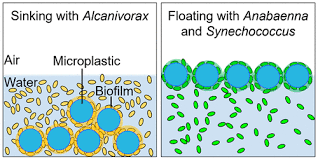Article
Biofilm Formation Influences the Wettability and Settling of Microplastic. Environmental Science & Technology Letters. ACS.
Amber J. Pete, Philip J. Brahana, Mustapha Bello, Michael G. Benton, and Bhuvnesh Bharti*Environmental Science & Technology Letters 2023, 10, 2, 159-164 (Contaminants in Aquatic and Terrestrial Environments)
Publication Date: October 25, 2022
Citations: 8
DOI: https://doi.org/10.1021/acs.estlett.2c00728
Abstract

The fate of 99% of the plastics present in oceans is unknown. It is presumed that biofilm formation on plastics leads to their sinking to the ocean floor, thus making them undetectable at the surface. While it is established that biofilms lead to sinking of plastics, it is the mechanism by which biofilms enhance the vertical transport of plastics that remains unknown. It is commonly assumed that biofilms increase the effective mass density of the plastics, which drives their sinking. Here, we show that such an assumption is not always true, and formation of biofilms alone is an insufficient criterion to predict the sinking or floating of plastics. We study the biofilm formation and vertical transport of polyethylene microplastics in the presence of Alcanivorax borkumensis, Anabaena sp., and Synechococcus elongatus. We find that while all three microorganisms formed biofilms on microplastics, only Alcanivorax led to their sinking. The sinking of microplastics is attributed to the production of highly active biosurfactants by Alcanivorax and its adsorption onto microplastics, which is not the case for Anabaena and Synechococcus. Our study highlights that it is not only the formation but the properties of the formed biofilms that govern the sinking or floating of plastics.
Copyright © 2024 Mustapha Bello. All Rights Reserved.
